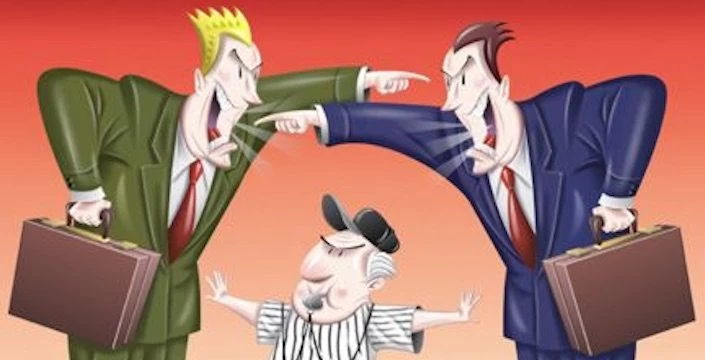Conflict resolution is crucial to maintaining a healthy and productive workplace environment. It involves addressing and resolving disputes or disagreements among individuals or groups within an organization. Conflicts can arise from various sources, such as differences in perspectives, goals, communication styles, or resource allocation. Effective conflict resolution is essential because unresolved conflicts can decrease morale, hinder collaboration, and reduce overall productivity.
We are often quick to point the finger when there are group problems. You can’t build effective teams while being surrounded by people who blame others for their failures, whether at work or at home – and this kind of blame-game environment can create a perpetuating cycle. Odds are, individuals who dole out blame for issues to their teammates are probably more motivated to protect their self-image than evade responsibility.
While team conflict is expected in the workplace, letting it run rampant should not be normalized. There are many ways that a manager can combat conflict within their team. Addressing conflict well fosters a positive organizational culture by promoting open communication, understanding, and cooperation. It helps build stronger relationships among team members, encourages innovation, and enhances overall team dynamics. Programs like our Conflict Resolution Training focus on the skills and strategies needed to build effective teams well-equipped to handle conflict.
By addressing conflicts promptly and constructively, organizations can create an environment where individuals feel heard, valued, and motivated to contribute their best efforts towards shared goals. This proactive approach minimizes disruptions and contributes to the long-term success and sustainability of the workplace.
The Importance of Conflict Resolution at Work
Conflict resolution is vital for maintaining a healthy workplace environment because it addresses underlying issues that, if left unattended, can escalate and negatively impact the organizational culture. A workplace with unresolved conflicts may experience increased stress, tension, and a decline in employee morale. Effective conflict resolution helps create a positive and collaborative atmosphere where individuals feel heard, respected, and valued. It fosters an environment that encourages open communication, trust, and a sense of fairness, all of which are crucial for the overall well-being of the workplace.
The benefits of effective conflict resolution extend to team dynamics and overall productivity. When conflicts are resolved constructively, team members gain a deeper understanding of each other’s perspectives and can work together more cohesively. This leads to improved collaboration, enhanced creativity, and a more positive team culture. Furthermore, resolving conflicts promptly prevents lingering resentment or animosity, allowing team members to focus on their tasks and goals rather than being preoccupied with interpersonal issues. Overall, effective conflict resolution contributes to a healthier, more productive workplace where individuals can thrive and teams can achieve their objectives efficiently.
Common Causes of Workplace Conflict
Conflicts in a team setting can arise from various scenarios or triggers, often rooted in differences in perspectives, goals, or communication styles. Some common scenarios include:
-
Communication Breakdown
Misunderstandings, poor communication, or lack of clarity in instructions can result in frustration and conflict among team members.
-
Personality Clashes
Differences in personalities, working styles, or approaches to problem-solving can lead to interpersonal conflicts within the team. Proactively working to understand personality types and traits within your team with a program like Myers-Briggs (MBTI) Training can help improve group communication and performance with diverse personality types.
-
Unhealthy Internal Competition
Intense competition for promotions, recognition, or scarce resources can create a competitive atmosphere that breeds conflict among team members.
-
Unclear Job Expectations
When team members are unsure about their roles, responsibilities, or performance expectations, it can result in frustration, resentment, and disputes about who should be doing what.
-
Ineffective Leadership
Leadership sets the tone for the team’s culture. When leaders fail to provide clear guidance, support, or effective communication, it can create an environment ripe for misunderstandings and interpersonal conflicts.
Understanding these potential triggers can help teams and leaders proactively address conflicts, promote open communication, and establish strategies for resolution, ultimately fostering a more collaborative and harmonious work environment.
5 Conflict Resolution Activities for Your Team
Team building activities are a valuable tool for improving communications and collaboration, helping to build relationships, and teaching time management skills. These components are essential foundations for developing and expanding conflict resolution skills. A detailed needs assessment can assist in determining the best program to advance your team’s specific needs and learning objectives. Here are some examples of team building activities and exercises that model the valuable strategies and skills needed to build trust, improve communication, and ultimately create a more resilient and collaborative team capable of resolving internal conflict.
-
Competitive Team Building
Foster team communication with a high-energy, competitive activity like Build-a-Raft! Employees will form teams and work together to build a ‘seaworthy’ raft using only the materials provided. The competition is literally sink or swim as each team takes to the water to test their craft to identify possible design flaws, boarding their rafts for a final relay race against the other teams.
Activities like Build-a-Raft that require strong team collaboration help build up employee communication. Building communication is vital to establishing healthy conflict resolution skills within the workplace.
-
Give Back With a CSR Activity
Corporate Social Responsibility (CSR) activities are a great way to pull your team out of the day-to-day minutia of the workplace. It gives your team a chance to be a part of something bigger than office conflicts or politics, and will put things into perspective. A collaborative CSR activity, such as Fostering Hope, is especially effective because your team not only gives back to the community but also improves their internal relationships through team building.
-
Escape Rooms
Escape room activities are a great tool to resolve inter-team conflict at work. Solving an escape room requires your team to put their differences aside and work together, a skill that will carry over to a workplace environment.
-
Professional Training
Managing conflict can be the difference between a simple “bump in the road” or lost productivity and long-term animosity in the workplace. Leadership training workshops like our Conflict Resolution Training are designed to guide managers to refine their natural conflict-handling styles. Strategies are introduced and honed to nurture a workplace culture well-positioned to handle conflict. Our professional facilitators tailor the techniques and styles covered in each training to the specific team’s needs and scenarios.
-
A Do-It-Yourself Exercise: The Blame Game
Incorporating a simple exercise into your next regular meeting is a great way to jumpstart your conflict resolution journey. We call this exercise “Blame Game Team Building.”
-
- Have your group form a circle with everyone standing.
- Start by pointing to someone in the circle. Continue pointing! That person now points to someone else and continues pointing. Keep going until everyone is pointing at someone else, and the last person then points at you!
- Everyone can stop pointing and focus on the person they are pointing at, or their “Person of Interest.” The objective now is for each person to imitate their person of interest’s every action.
- Now, ask your group not to move unless their person of interest moves (blinks, coughs, twitches, etc.); then, they must copy that exact movement and be still again.
- Continue play for 3-5 minutes.
- When you’re finished, reflect on the activity. What happened when everyone was supposed to stand still? You can expect blame to be placed here on someone perceived to move first. Let some accusations occur; it will become clear that it’s nearly impossible to pinpoint who started each movement. Then ask – how much does it matter who started it once it started? How much energy do we put into looking for scapegoats? And most importantly – how can we see this same mannerism embedded in our workplace dynamics?
Fostering a Culture of Positive Conflict Resolution
As established above, effectively managing and resolving conflict is a crucial skill for the corporate workplace and team dynamics. In addition to formal training and team building activities, leaders can leverage several proactive practices and behaviors to reinforce team conflict resolution skills.
Actionable Tips
First and foremost, managers must lead by example. When leaders demonstrate practical conflict resolution skills, model open communication, actively listen, and are willing to address conflicts constructively, those behaviors set the tone for the team. An environment where team members feel comfortable expressing their opinions and concerns is also essential. Encourage open dialogue and establish regular communication channels, such as team meetings or one-on-one check-ins. Regularly offering constructive feedback on individual and team performance prevents minor issues from escalating into more significant conflicts.
Ensuring clearly defined roles, responsibilities, and expectations minimizes ambiguity that can lead to conflicts. Team members should understand how their individual contributions align with overall team goals. In addition to clear individual expectations, encouraging collaboration reduces the likelihood of conflict by fostering a culture where working together towards common goals is valued. When disputes arise, as they inevitably will, having an established resolution procedure that the whole team understands helps create a sense of transparency and fairness. Foster a supportive workplace culture where team members feel comfortable seeking help when conflicts arise. Encourage collaboration over competition, emphasizing that conflict resolution is a shared responsibility.
Long-Term Benefits of a Proactive Approach to Conflict Management
A proactive approach to conflict resolution jumpstarts the positive benefits of its effective management.
Teams skilled in conflict resolution are better equipped to address challenges and solve problems collaboratively. This leads to more effective problem-solving and adaptability to changing circumstances. And when teams are more comfortable addressing conflicts, they are more likely to engage in open discussions, share diverse ideas, and feel empowered to express their viewpoints, fostering innovative problem-solving.
Addressing conflicts promptly prevents prolonged disruptions and allows the team to focus on tasks and goals. This contributes to increased productivity and efficiency in the long run. A workplace that values effective conflict resolution creates a positive and supportive atmosphere that attracts top talent through a positive reputation, promotes higher morale among team members, and increases job satisfaction and employee retention. Employees are more likely to stay in an environment where they feel heard and supported.
By investing time and effort in creating a workplace culture that values and promotes effective conflict resolution, leaders and managers contribute to the long-term success and sustainability of the organization. The benefits extend beyond resolving individual conflicts to positively impact team dynamics, employee satisfaction, and overall organizational performance.
Wrapping it Up
The significance of conflict resolution in the workplace must be emphasized, particularly in the context of team building. Navigating conflicts effectively lies at the heart of fostering collaborative, productive, and positive team dynamics. By addressing conflicts head-on, teams can build trust, enhance communication, and create an environment where diverse perspectives contribute to innovation rather than discord.
Recognizing the value that training and continuous learning bring to conflict management is equally crucial. Investing in developing conflict resolution skills through targeted training programs equips teams with practical tools and instills a proactive mindset. Teams that engage in continuous learning are better prepared to adapt to changing circumstances, prevent conflicts before they arise, and integrate a culture of effective conflict resolution into their daily interactions.
As organizations strive for success in a dynamic and interconnected world, the ability to manage conflicts constructively emerges as a critical differentiator. It is not merely a reactive measure but a proactive strategy that contributes to the long-term health, productivity, and resilience of both individuals and the collective team. By prioritizing conflict resolution and fostering a culture of continuous learning, workplaces can truly become incubators for collaboration, growth, and sustained success. Contact Best Corporate Events today to resolve conflict resolution at your workplace through engaging team building activities designed for your organization .


